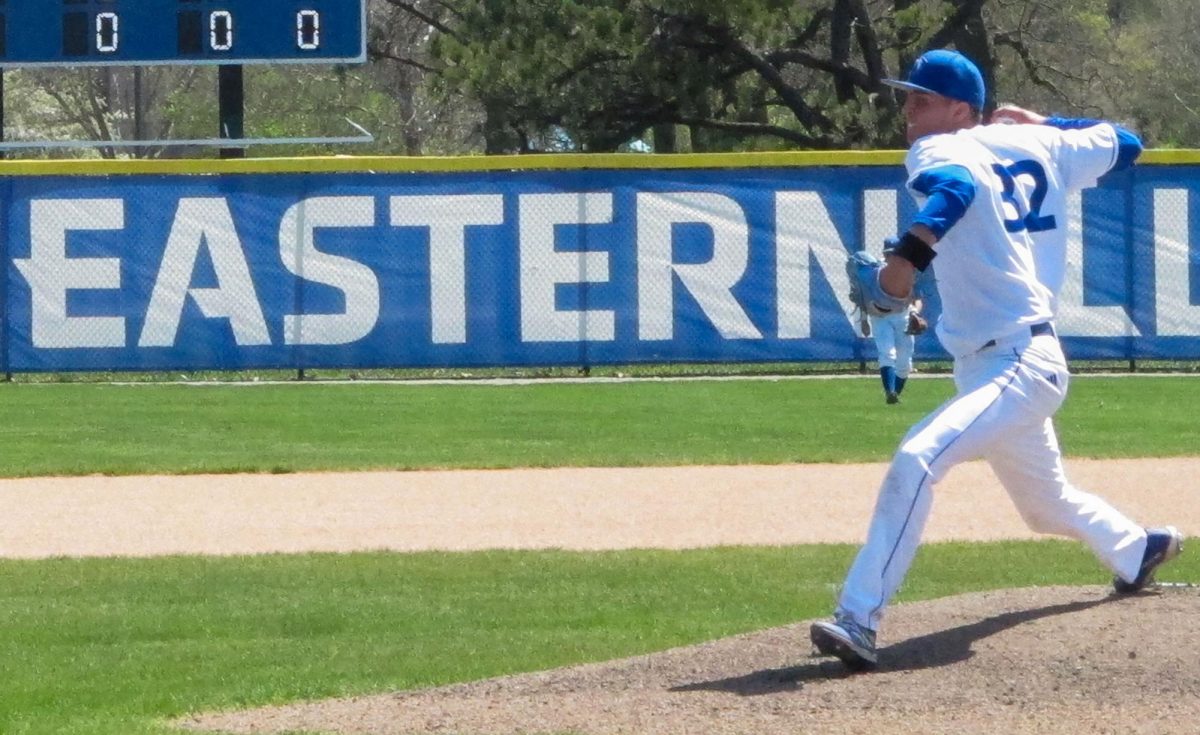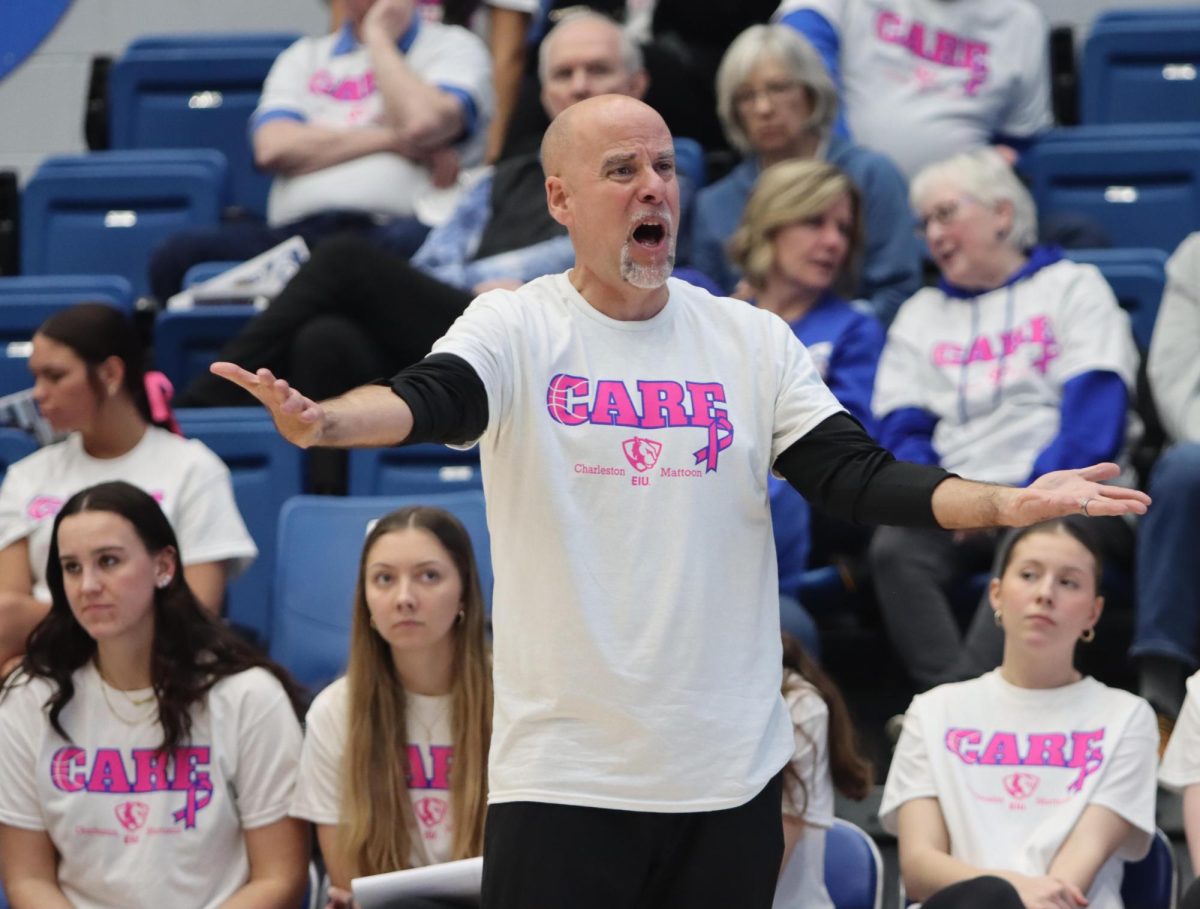It’s only a drill
Marifie Henson leaned on her best friend’s shoulder as the two walked into Eastern’s Health Service Thursday morning.
Henson, senior nursing student, had returned earlier in the week from visiting her family in Indonesia where she’d come into contact with the H5N1 virus or more commonly known as the Avian Flu.
Now she was sick: vomiting, weakness, respiratory distress. To the nurse on duty it just looked like the flu or maybe the mumps. Regardless, she took action immediately. Henson and Krystal Pearcy, the best friend, were quickly confined to a sick room with a two-way mirror, one entrance and a special sink, which Henson could vomit in.
At first, the staffer caring for Henson did not put on gloves or a mask. But this was quickly rectified once she realized that Henson’s illness was something serious.
Dr. Sheila Baker and another nurse – complete with masks – soon took over. The two were also wearing imaginary gowns and shoe scrubs, which they simulated putting on.
Next, the door was closed to avoid contaminating the rest of the clinic and a sign “Consult Nurse before entering” was taped to the door.
Behind the closed door, Baker quizzed Henson about her past couple days and soon discovered that she’d been traveling and had possibly come into contact with Avian Flu.
She immediately requested a cell phone and told another nurse to call an ambulance.
Six days earlier
The above situation was the climax in a drill organized by the Coles County Health Department, Sarah Bush Lincoln Health Center and Eastern Health Service. The drill started on Oct. 26 with e-mailed injects to participating parties.
“What we tried to do is play this event out in real time,” said Gregg Baker, drill coordinator for Coles County Health Department. “A public health emergency does not happen in the same way in an emergency for the fire department. . With public health we have to look for things like trends and look at things in the bigger picture (beyond the state) so playing that out is difficult.
“As a result of that we need to focus on drills that are longer and a lot more information as far as injects go to create a plausible situation.”
The injects are what established the back story and trend for this drill. Injects can be anything from fictitious press releases and newspaper articles that help set the scenario of the drill to actual Center for Disease Control guidelines that are e-mailed to drill participants.
This drill’s purpose was to not only evaluate the response from the county’s main three medical organizations, but also evaluate the communication between them and the press.
Therefore Eastern’s Media Relations and a staff member from the Daily Eastern News also participated.
A total of eight agencies were involved with the drill including the above mentioned as well as the Charleston Fire Department, the Mitchell Jordan Ambulance, and the family medical clinic in Mattoon.
The Storyline
To hold an effective drill, a story line had to be developed. It started like this.
Day 2 of injects: A girl from Indonesia died from the H5N1 virus after coming into contact with infected poultry.
Day 4 of injects: In Indonesia, the Avian flu virus mutated so that it could transmit from human to human. (In real life, the virus is spread only bird to human.) This same day the Center for Disease Control confirms an Avian flu case in California. The infected female was on Singapore Airlines Flight 157 from Jakarta, Indonesia.
Day 5 of injects: Another passenger of Flight 157 is confirmed to Avian flu – this time in Chicago.
President Bush authorizes the purchase of 5 million doses of a controversial flu vaccine that has not been approved by the U.S. Food and Drug Administration. (This vaccination does not exist in real life.)
Day 6 of injects: Another passenger of Flight 157 is confirmed to have the Avian flu – this time in Missouri.
Day 7: Henson checks into Health Service as the fourth passenger to become sick from Flight 157.
Emergency response
Back at Health Service after the ambulance was called, preparations to safely transport Henson began. All the doors leading into the main hallway, through which Henson would travel on a paramedic stretcher, were closed. The remaining Health Service Staff secluded themselves.
Nearly five minutes later, two paramedics were rolling a stretcher down the hallway, toward the quarantined room. Gary Hanebrink, Eastern’s safety officer and drill coordinator, commented that had the drill been real, the ambulance would have arrived in three minutes.
Henson was then loaded onto the stretcher and taken down the hallway – where she vomited half way – and onto the ambulance to be transported to Sarah Bush.
Dr. Baker then began giving instructions to Pearcy about isolating herself. After this, Baker called a nurse outside the containment room to find out the guidelines for disinfecting the room.
Baker would later comment that having the cell phone and putting Henson in the room with the two-way mirror were good decisions because they helped facilitate communication without further contaminating the staff.
Other phone calls were made to Dan Nadler, vice president for student affairs, and Vicki Woodard, Eastern’s Public Information Officer and director of Medial Relations.
The drill at Health Service lasted an hour and a half.
Nothing happens without a hitch
Through out the drill, Baker and Hanebrink stressed they didn’t expect the drill to occur without a hitch.
The first hitch occurred early Thursday morning when the Daily Eastern News photographer accidentally informed the Health Service staff that the drill was going to happen.
“This drill was unannounced by design by the Health Service management,” Hanebrink said.
At first, the staff did not want to continue the drill as they felt the element of surprise had been ruined. But upon further discussion, it was decided to continue drill but on a lesser scale – only having one sick student instead of multiple – since the second part of the drill at Sarah Bush depended on the plot line at Health Service.
“This will be a good learning experience,” said Lynette Drake, director of Health Services after the drill was complete. “The drill lets you see what is working.”
Another hitch occurred once Henson arrived at Sarah Bush. A real emergency happened.
“The rest of the drill was very active for 15 minutes at Sarah Bush,” Hanebrink said. “Then (the hospital) went into Emergency lockdown because one of the real patients got up and walked away.”
The drill had to stop while staffers searched for the missing patient. This concluded the drill early, which prevented a lot of the plotline from developing, Hanebrink said.
Final Evaluation
Overall, the drill accomplished its purpose in that it got people to think, according to Baker and Hanebrink.
While Baker acknowledged that real world events cut the drill short, he was pleased with the result.
“Each agency does a lot of drilling on their own,” he said. “Yesterday (Thursday) we burst that bubble and got everybody involved. . It was the first one that we tried to do that way, and I thought it was beneficial.”
Hanebrink was impressed with the way Health Service – specifically Dr. Baker – handled the drill with such professionalism.
“I think it went well at the university,” he said. “Sheila Baker did a trooper’s job of managing the scenario. The fire department’s response was appropriate for the information given. For the patients, it went well.”
Hanebrink also caught some areas that could be improved or “points of discussions” he termed them.
The first was when Henson pretended to vomit in the hallway on the way to the ambulance.
“I saw that other departments may need to be called in to do some clean-up,” he said.
He plans to look at an early activation plan for the building services workers in the event of such an emergency.
Woodard termed the drill as neither a failure nor a success, as the Media Relation department was not as involved as it originally planned on being.
One positive Woodard touched on was that the drill enabled her to talk to the different entities and get to know people who would be involved in such a situation before such an emergency might happen.
One aspect she said that became clear as the drill progressed was that many people on campus don’t fully understand the Department of University Communications’ role.
“I had the impression that they thought for example that our response was going to be such and such when really that wasn’t our role,” she said. “That was good to find out.”
She recommended that the University departments as a whole undergo an education process that explains what each department is doing and explain their roles in the university.
Those involved with the drill will meet at 9a.m., today at the Sarah Bush Education Center to decide what kind of training needs to be implemented and plan a future drill to retest everything.
“This was a great learning experience for everyone body involved,” Baker said. “I hope that this is the direction that we start going as far as doing drills together.”












































